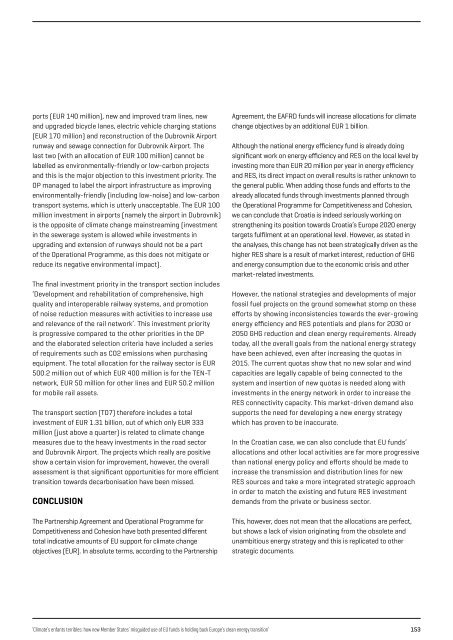ENFANTS TERRIBLES
enfants-terribles
enfants-terribles
You also want an ePaper? Increase the reach of your titles
YUMPU automatically turns print PDFs into web optimized ePapers that Google loves.
ports (EUR 140 million), new and improved tram lines, new<br />
and upgraded bicycle lanes, electric vehicle charging stations<br />
(EUR 170 million) and reconstruction of the Dubrovnik Airport<br />
runway and sewage connection for Dubrovnik Airport. The<br />
last two (with an allocation of EUR 100 million) cannot be<br />
labelled as environmentally-friendly or low-carbon projects<br />
and this is the major objection to this investment priority. The<br />
OP managed to label the airport infrastructure as improving<br />
environmentally-friendly (including low-noise) and low-carbon<br />
transport systems, which is utterly unacceptable. The EUR 100<br />
million investment in airports (namely the airport in Dubrovnik)<br />
is the opposite of climate change mainstreaming (investment<br />
in the sewerage system is allowed while investments in<br />
upgrading and extension of runways should not be a part<br />
of the Operational Programme, as this does not mitigate or<br />
reduce its negative environmental impact).<br />
The final investment priority in the transport section includes<br />
‘Development and rehabilitation of comprehensive, high<br />
quality and interoperable railway systems, and promotion<br />
of noise reduction measures with activities to increase use<br />
and relevance of the rail network’. This investment priority<br />
is progressive compared to the other priorities in the OP<br />
and the elaborated selection criteria have included a series<br />
of requirements such as CO2 emissions when purchasing<br />
equipment. The total allocation for the railway sector is EUR<br />
500.2 million out of which EUR 400 million is for the TEN-T<br />
network, EUR 50 million for other lines and EUR 50.2 million<br />
for mobile rail assets.<br />
The transport section (TO7) therefore includes a total<br />
investment of EUR 1.31 billion, out of which only EUR 333<br />
million (just above a quarter) is related to climate change<br />
measures due to the heavy investments in the road sector<br />
and Dubrovnik Airport. The projects which really are positive<br />
show a certain vision for improvement, however, the overall<br />
assessment is that significant opportunities for more efficient<br />
transition towards decarbonisation have been missed.<br />
CONCLUSION<br />
The Partnership Agreement and Operational Programme for<br />
Competitiveness and Cohesion have both presented different<br />
total indicative amounts of EU support for climate change<br />
objectives (EUR). In absolute terms, according to the Partnership<br />
Agreement, the EAFRD funds will increase allocations for climate<br />
change objectives by an additional EUR 1 billion.<br />
Although the national energy efficiency fund is already doing<br />
significant work on energy efficiency and RES on the local level by<br />
investing more than EUR 20 million per year in energy efficiency<br />
and RES, its direct impact on overall results is rather unknown to<br />
the general public. When adding those funds and efforts to the<br />
already allocated funds through investments planned through<br />
the Operational Programme for Competitiveness and Cohesion,<br />
we can conclude that Croatia is indeed seriously working on<br />
strengthening its position towards Croatia’s Europe 2020 energy<br />
targets fulfilment at an operational level. However, as stated in<br />
the analyses, this change has not been strategically driven as the<br />
higher RES share is a result of market interest, reduction of GHG<br />
and energy consumption due to the economic crisis and other<br />
market-related investments.<br />
However, the national strategies and developments of major<br />
fossil fuel projects on the ground somewhat stomp on these<br />
efforts by showing inconsistencies towards the ever-growing<br />
energy efficiency and RES potentials and plans for 2030 or<br />
2050 GHG reduction and clean energy requirements. Already<br />
today, all the overall goals from the national energy strategy<br />
have been achieved, even after increasing the quotas in<br />
2015. The current quotas show that no new solar and wind<br />
capacities are legally capable of being connected to the<br />
system and insertion of new quotas is needed along with<br />
investments in the energy network in order to increase the<br />
RES connectivity capacity. This market-driven demand also<br />
supports the need for developing a new energy strategy<br />
which has proven to be inaccurate.<br />
In the Croatian case, we can also conclude that EU funds’<br />
allocations and other local activities are far more progressive<br />
than national energy policy and efforts should be made to<br />
increase the transmission and distribution lines for new<br />
RES sources and take a more integrated strategic approach<br />
in order to match the existing and future RES investment<br />
demands from the private or business sector.<br />
This, however, does not mean that the allocations are perfect,<br />
but shows a lack of vision originating from the obsolete and<br />
unambitious energy strategy and this is replicated to other<br />
strategic documents.<br />
‘Climate’s enfants terribles: how new Member States’ misguided use of EU funds is holding back Europe’s clean energy transition’ 153


